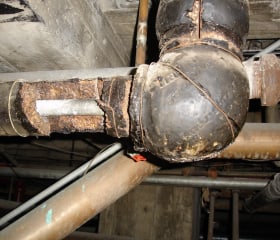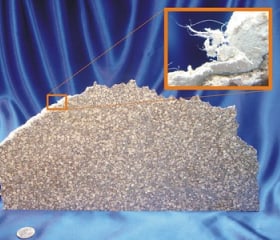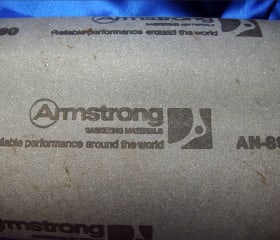Armstrong World Industries
Armstrong World Industries manufactured asbestos products from the 1930s to the 1970s. Asbestos litigation caused the company to file for bankruptcy in 2000. An asbestos trust fund became active in 2007 and it contains more than $2 million to compensate victims.

Armstrong’s History With Asbestos
Armstrong World Industries began as a wine bottle cork manufacturer in 1860. The company expanded its product offerings to include insulating corkboard, fiberboard and flooring materials. It also began incorporating asbestos into these products.
Though it may be an effective insulator, asbestos is a toxic mineral linked to an estimated 90,000 global casualties every year. It can cause deadly conditions like mesothelioma, lung cancer and asbestosis.
1930s
Decade when Armstrong World Industries began incorporating asbestos into its products. Its use was phased out in the 1970s.
Asbestos presented a cheap and effective option for the company’s insulation needs. In the 40-year production period, Armstrong shipped its asbestos products to homes, businesses and industrial facilities nationwide.
Armstrong World Asbestos Products
Armstrong manufactured various asbestos-containing products such as adhesives, backing and floor tiles. It was important for these products to be fire-resistant, so asbestos was a suitable material until later research showed the risks.
- Asbestos Adhesives and Mastics
-
- Adhesives and mastics are materials used to bind and preserve insulation products.
- Over time, Armstrong asbestos cork pipe insulation became friable (crumbly) and spread throughout a building, posing a hazard to installation workers and residents of affected buildings.
- S-89 and S-90 adhesives can dry out and become friable with age. Homeowners or maintenance workers disturbing the adhesive may release asbestos dust.
- Black mastic asbestos is an asbestos-based adhesive used to set flooring in place. It’s generally considered harmless if left undisturbed but can become dangerous if broken up or improperly removed.

- Asbestos Backing, Felt and Paper
-
- Asbestos backing, felt and paper were often used underneath flooring and roofing. They’re some of the most hazardous forms of asbestos.
- Armstrong hydrocord asbestos backing, a type of vinyl sheet flooring, is highly friable. Disturbing it can release fibers into the air, making it dangerous for residents and construction workers.
- Asbestos felt and paper are both frail and highly friable materials. They’re extremely hazardous for anyone near them.

- Asbestos Flooring
-
- Armstrong asbestos tiles and flooring were used as flooring finishes in countless homes. They can become friable, and fibers will become airborne if broken, so they’re dangerous for installers.

- Asbestos Gaskets
-
- Asbestos gaskets create seals between pipes and machine parts. They pose a significant risk to those who install or remove them.

If you’ve used, worked with or lived in an area containing these Armstrong products, you may have been exposed to asbestos. You may be entitled to compensation for the resulting health conditions.
Occupations Exposed to Armstrong World Asbestos Products
Employees at Armstrong’s manufacturing facilities as well as workers installing asbestos products in homes and buildings were exposed to asbestos fibers released into the air during production and installation. While consumers also could be exposed, the risk for people who worked with asbestos directly is significantly higher. Spending extensive time around asbestos increases the likelihood and severity of related health conditions.
- Construction/demolition worker
- Factory worker
- Firefighter
- Insulator
- Mine worker
- Navy veteran
Anyone who has worked in these fields and is diagnosed with conditions such as mesothelioma, may be able to trace their condition to asbestos exposure from Armstrong products. If you believe that a job site exposed you to asbestos, you may be able to receive compensation from Armstrong.
Health Risks and Impact
Asbestos exposure is the leading cause of mesothelioma. The carcinogen is also responsible for several other diseases. When inhaled, asbestos fibers become lodged in the lungs, causing inflammation and, eventually, dangerous symptoms.
- Asbestosis
- Laryngeal cancer
- Lung cancer
- Mesothelioma
- Pericardial effusion
- Peritoneal effusion
- Pleural effusion
- Pleural plaques
- Pleural thickening
- Ovarian cancer
If you have been diagnosed with any of these conditions and suspect that asbestos exposure was the cause, get in touch with an attorney. The Armstrong World Asbestos Trust has a list of medical requirements, but you should first consult an asbestos attorney. Even if you don’t meet the listed requirements, you may still have a case.
Armstrong World Industries Asbestos Litigation
Armstrong World Industries has been involved in numerous asbestos lawsuits starting in the 1970s and continuing to the present day. Lawsuits and settlements took a toll on Armstrong, so the company declared bankruptcy protection in December 2000. It later reorganized and formed a trust.
During the three-year period immediately prior to its Dec. 6, 2000, chapter 11 filing, AWI paid over $500 million in settlement payments (including defense costs) on account of asbestos-related personal injury and wrongful death claims.
The courts have consistently ruled that Armstrong knew the dangers of asbestos but failed to inform employees and consumers, thereby endangering them. Among the thousands of asbestos cases the courts have processed since the ‘70s, a few stand out as landmarks that defined later cases.
Armstrong Named a Defendant in Borel v. Fibreboard Paper Products Corp.
Borel v. Fibreboard Paper Products Corp. in 1970 was one of the first landmark Armstrong World Industries asbestos cases. The plaintiff, Clarence Borel, sued Armstrong and 10 other manufacturers of asbestos products after developing mesothelioma and asbestosis as a result of using their products. Borel was an insulation worker and frequently came in close contact with dangerous asbestos products. He didn’t know of the risk until he had already developed asbestosis.
Borel claimed the manufacturers had failed in their duty to warn him and his colleagues of the risks of asbestos. Though he understood that it was “bad for [him]” according to the case, he was never fully aware of the dangers until his asbestosis diagnosis.
The courts sided with Borel, declaring that asbestos manufacturers were responsible for disclosing any risks their products posed. This was a monumental case for those diagnosed with conditions linked to asbestos exposure, allowing them to receive millions in compensation from Armstrong World Industries and other asbestos companies.
Miller v. Armstrong World Industries
Raymond Miller brought his case against Armstrong World Industries in 1991. Miller worked as an insulator from 1946 to 1951 and used Armstrong asbestos products under the impression they were safe. As a direct result of his frequent exposure to asbestos, Miller was diagnosed with pleural thickening in the 1980s. An asbestosis diagnosis followed shortly after.
Miller’s claim sought compensation for his asbestosis, but Armstrong World Industries argued it not liable under Colorado law. Colorado has a two-year statute of limitations between the diagnosis of a condition and the affected party’s ability to file a claim. Because the statute of limitations had passed on Miller’s initial diagnosis of pleural thickening, Armstrong also argued he couldn’t sue for his asbestosis.
The courts initially sided with Armstrong, but the ruling was soon overturned in favor of Miller. This set a precedent for all future cases in Colorado, giving each disease diagnosis its own statute of limitations. Under this precedent, a diagnosis of one disease couldn’t affect the statute of limitations for future diagnoses, helping survivors get the compensation they deserved.

Gain access to trust funds, grants and other forms of compensation for you or your loved ones.
Get Help NowArmstrong’s Bankruptcy and Asbestos Trust
The multitude of asbestos payouts quickly drained Armstrong’s financial resources, causing the company to declare bankruptcy in 2000. It reorganized in 2006 and founded the Armstrong World Industries Asbestos Trust, which began accepting claims in 2007. The trust has since received hundreds of thousands of claims and paid out millions in damages.
13.5%
Percentage trustees reduced Armstrong World trust payment on May 31, 2023.
Though this means less payout per individual, it ensures the trust will have enough money to pay everyone who files a claim. Once you file, the trust will send you a release. Upon signing the release and returning it to the trust, you should receive a payment within 1-2 months.
Armstrong Flooring was initially connected to Armstrong World Industries. However, the flooring company filed bankruptcy and separated from AWI in 2016. It is completely unrelated to the trust. The bankruptcy will not affect your ability to file a personal injury claim or receive a payout.
Recommended Reading


